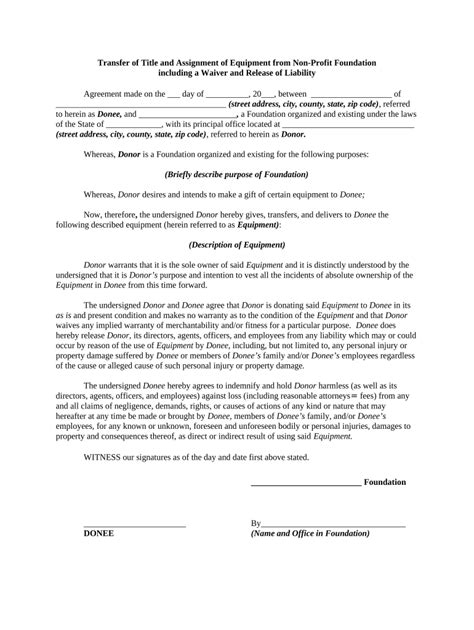How To Transfer Ownership Of A Non Profit
Ronan Farrow
Apr 02, 2025 · 3 min read

Table of Contents
How to Transfer Ownership of a Non-Profit Organization
Transferring ownership of a non-profit organization is a complex process that requires careful planning and execution. It's not a simple matter of signing over the deed; it involves legal, financial, and ethical considerations to ensure the smooth continuation of the organization's mission. This guide will walk you through the key steps involved.
Understanding the Nuances of Non-Profit Ownership
Unlike for-profit businesses, non-profits don't have "owners" in the traditional sense. Instead, they are governed by a board of directors who are responsible for overseeing the organization's activities and ensuring they align with its mission. Therefore, "transferring ownership" typically refers to the transition of control and responsibility from one governing body to another. This might involve:
- Merger with another non-profit: Combining with a similar organization to expand reach and resources.
- Acquisition by another non-profit: One organization taking over the operations of another.
- Succession planning: A planned transition of leadership within the existing organization.
Key Steps in Transferring Control of a Non-Profit
The specific steps will vary based on the type of transfer, your state's regulations, and your organization's bylaws. However, these general steps are crucial:
1. Thorough Due Diligence and Assessment
Before initiating any transfer, conduct a comprehensive review of:
- Financial health: Assess assets, liabilities, and ongoing financial obligations. A clean financial picture is essential for attracting a potential successor.
- Legal compliance: Ensure all regulatory requirements are met, including tax filings and adherence to state and federal laws governing non-profits.
- Program effectiveness: Evaluate the impact of the organization's programs and identify areas for improvement or refinement. This information will be crucial for attracting another organization interested in continuing your mission.
2. Develop a Detailed Transition Plan
A well-structured plan is critical for a smooth transition. This plan should include:
- Timeline: Establish clear deadlines for each stage of the process.
- Responsibilities: Assign specific roles and responsibilities to individuals involved in the transfer.
- Communication strategy: Develop a plan to keep stakeholders (staff, donors, beneficiaries) informed throughout the process.
- Legal counsel: Engage legal professionals specializing in non-profit law to guide you through the complexities of the process.
3. Secure Necessary Approvals
This will often involve:
- Board of directors approval: The current board must approve the transfer.
- Donor consent: If applicable, seek consent from major donors regarding the transfer.
- State regulatory approvals: Depending on your state's regulations, you may need to obtain approval from the relevant state authority.
4. Formalize the Transfer
The specific method of formalizing the transfer will depend on the type of transfer:
- Merger: This involves filing the necessary paperwork with the state to legally combine the two organizations.
- Acquisition: This usually involves a formal agreement outlining the terms of the transfer, including assets, liabilities, and ongoing responsibilities.
- Succession planning: This usually involves a phased handover of responsibilities to new leadership within the organization.
5. Post-Transfer Monitoring
Even after the transfer is complete, it's crucial to monitor the transition to ensure the new organization effectively carries on the mission of the original organization.
Legal and Ethical Considerations
Throughout the entire process, ethical and legal considerations should be paramount. This includes:
- Transparency and accountability: Maintain transparency throughout the entire process.
- Protection of assets: Ensure the organization's assets are protected throughout the transfer.
- Beneficiary interests: Prioritize the interests of the beneficiaries of the organization's programs.
Transferring ownership of a non-profit is a significant undertaking. By carefully following these steps and seeking professional guidance, you can ensure a smooth and successful transition, preserving the legacy and impact of your organization. Remember, seeking advice from legal and financial professionals specializing in non-profits is crucial throughout this process.
Featured Posts
Also read the following articles
| Article Title | Date |
|---|---|
| How To Remove Walnut Stains | Apr 02, 2025 |
| How To Test Rear Window Defroster | Apr 02, 2025 |
| How To Remove Mercury Throttle Handle | Apr 02, 2025 |
| How To Stop A Puppy From Jumping Up And Biting | Apr 02, 2025 |
| How To Train For A 400m | Apr 02, 2025 |
Latest Posts
Thank you for visiting our website which covers about How To Transfer Ownership Of A Non Profit . We hope the information provided has been useful to you. Feel free to contact us if you have any questions or need further assistance. See you next time and don't miss to bookmark.
